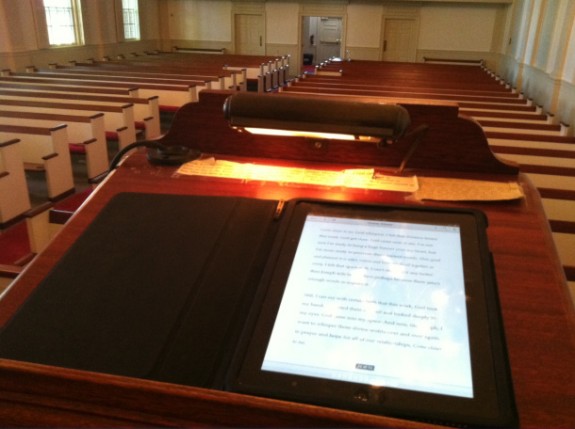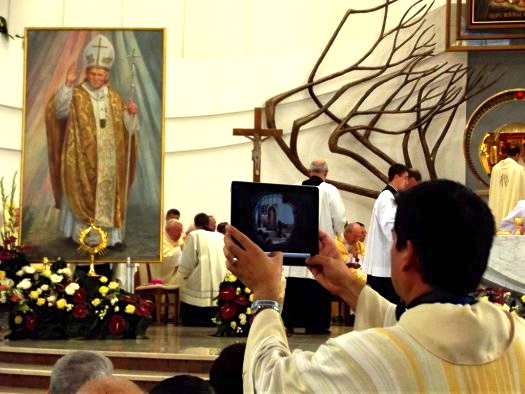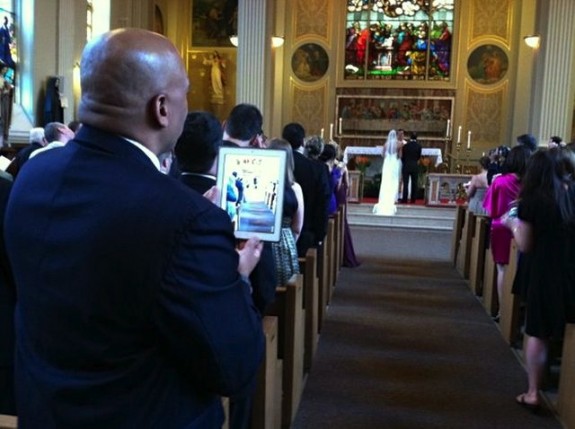Priests have been known to use them for celebrating Mass and for preaching. But the debate about whether it’s appropriate to use iPads in church goes on.
Protestant ministers are weighing in:
The tablet may undermine the spatio-temporal nature of church. When a member stands before the congregation, reading the sermon text from a tablet, there is something missing, something lifeless at play. Again, John Bombaro observes, “Digital texts are ephemeral; they are ontologically diminished.” There’s no “there” there, Bombaro laments.
Surely this should rub us wrong, as physical beings who gather together as an assembly in a tangible place. We see with our own eyes a standing, breathing minister preach about a God who is, yes, invisible, but is really with us as Lord of space and time. This God has made himself known by sending his own Son in flesh and blood.
When the spatio-temporal nature of Scripture is replaced with a digital, even ephemeral, cyberspace text, there is an awkward inconsistency at play given the physicality of baptism and the Lord’s Supper. In the lineage of the Reformation, evangelicals have long affirmed at least three marks of the church and means of grace: the proclamation of God’s Word, baptism, and the Lord’s Supper. Why not perform a baptism in private or take the Lord’s Supper alone? There is an essential corporate dimension to these somatic means of grace, as the church witnesses the gospel in the waters of baptism and together partakes of the flesh and blood of Christ represented in the elements. The materiality of these means visually remind us that we are accountable to this gospel and to one another.
Likewise with God’s Word. The Scriptures, preached and read, teach us, reprove us, and train us in righteousness so that we are equipped for every good work (2 Tim. 3:16-17). If baptism and the Lord’s table become lifeless when we disintegrate their materiality, do we not risk a similar danger when we remove the spatio-temporal presence of the Word of God for the people of God? And should an unbeliever walk in for the first time, would he know that we are a people of the book?
When the smartphone or iPad (or name your mobile device) replaces a hardcopy of Scripture, something is missing in our nonverbal communication to unbelieving onlookers. When you walk to church, sit down on a bus, or discipline one another at a coffee shop, a hard copy of the Bible sends a loud and bold message to the nearest passersby about your identity as a Christ follower. It says, “Yes, I am a Christian and I believe this book is the Word of God telling us who we are and how we should live.”
Another pastor has a different take:
Thanks to smartphone Bible apps, people have access to the text at times and in places they ordinarily wouldn’t. Most of us don’t carry printed Bibles everywhere we go. I can’t count the number of times prior to the advent of smartphones that I wanted to check a quotation, look up a cross reference, or simply read but couldn’t thanks to the fact that I didn’t have a physical copy of the Bible near to hand. Those days are pretty much over. Because the technology is still relatively new, people who don’t ordinarily take an interest in the Bible seem to get excited about it. Outside the Bible Design Blog community, I never have people recommending Bibles to me, but in the past couple of weeks I’ve had Bible apps suggested by a variety of people, many of whom I wouldn’t have pegged as reading enthusiasts.
While I’m not a great reader of e-books, as an author I am in love with them. When I receive an e-mail from a new fan of my novels, do you think I worry about whether they read the printed book or the e-book (or listened to the audiobook for that matter)? What matters is that they’ve read the book. They’ve connected with my words. If the convenience and novelty of e-books –– not to mention the economics –– lead to more people reading, that’s a result.
My hope for e-books is not that they’ll go away, but that in the future they will get better, eventually surpassing physical books. They have a long way to go, however. (See “The Form of Digital Books.”)
The downside I see with the use of Bible apps is not the software itself, but the larger context of the media consumption device — not the e-books, in other words, but the e-readers. When sermons bored me as a kid, I found myself flipping through the color maps in the back of the Bible. If you bore me while I’m holding my iPad, I have more sophisticated means of distraction at my fingertips.
Speaking for myself, I’d be happy to see Catholics come to church with anything beside juice boxes and beach bags.
One interesting phenomenon, though, is the increased presence of iPads at weddings and baptisms, replacing traditional cameras. This can be weirdly disconcerting; at key moments in the liturgy the congregation is transformed into a wall of tablets. Faces vanish. Capturing the experience digitally becomes more important than the experience itself.
We don’t live life anymore. We shoot it.
Meantime, this preacher has some tips for anyone planning to use the iPad in the pulpit.
I’m still a Luddite, using mere paper for my text. But like Eve, I keep getting tempted by Apple…














